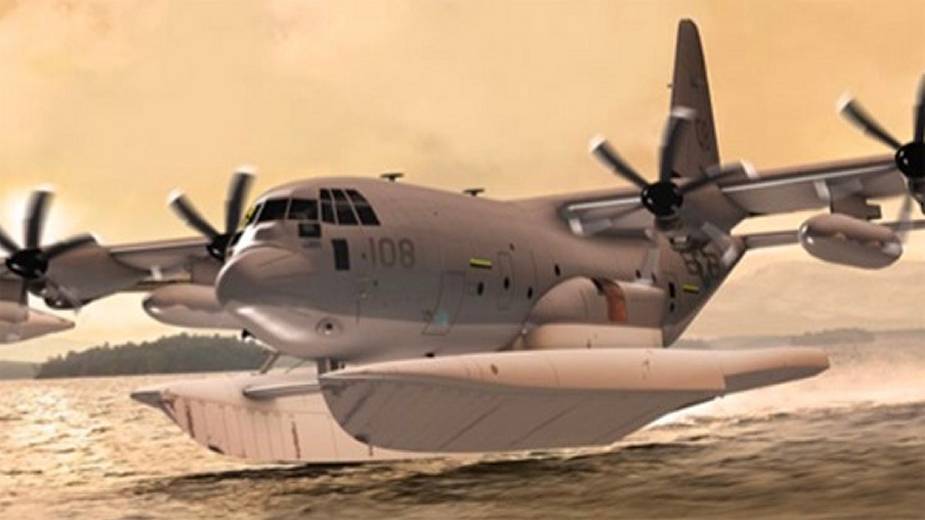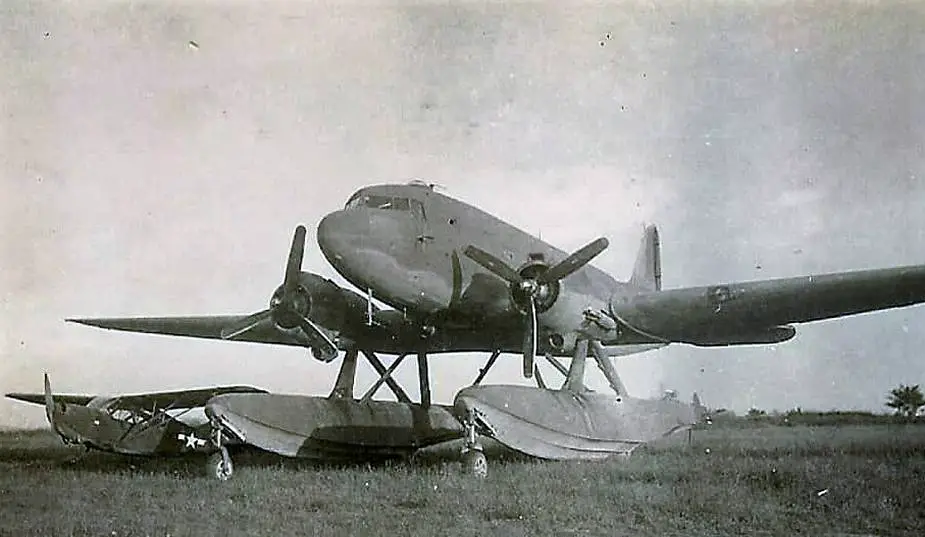The idea of an "amphibious" C-130 Hercules dating back to the1960s was not completely abandoned, Laurent Lagneau reports in Opex360, Lockheed-Martin having considered equipping the aircraft with floats. Still unsuccessful, although the US Coast Guard might have been interested. Eventually, as needs have since evolved, such a concept may well materialize, with the US Special Operations Command [USSOCOM] now deeming it relevant to the operations they expect to conduct in the years to come.
Follow Air Recognition on Google News at this link
 Artist rendering of a Lockheed Martin MC-130J Commando II fitted with floats. However, as the aircraft would have to be able to operate from water as well as from the hard ground, the shape of the floats as drawn here appears bearly compatible with retractable wheels, a common design on dual-use floatplanes (Picture source: USSOCOM)
Artist rendering of a Lockheed Martin MC-130J Commando II fitted with floats. However, as the aircraft would have to be able to operate from water as well as from the hard ground, the shape of the floats as drawn here appears bearly compatible with retractable wheels, a common design on dual-use floatplanes (Picture source: USSOCOM)
USSOCOM is now focusing on rivalry with Russia and China. And the Indo-Pacific region is one of its priorities. Hence the idea of bringing the concept of the amphibious C-130 Hercules out of the drawers. So, Laurent Lagneau reports, on May 19, 2021, during a conference organized by USSOCOM for the industry (SOFIC - Special Operations Forces Industry Conference), Colonel Ken Kuebler unveiled the "MC-130 Amphibious Capability" (MAC) program. , which consists of providing an amphibious capability to the Lockheed MC-130J Commando II, ie the version of the KC-130J Hercules used by the American special forces. The device could thus operate on land as well as at sea. As a reminder, the MC-130J Commando II was designed to carry out infiltration/exfiltration missions in hostile or "politically sensitive" areas.
According to Colonel Kuebler, feasibility studies are currently underway, with "innovative partners", which he did not see fit to specify. The task is actually complicated. "It's a challenge," he admitted. According to Janes, such a modified MC-130 Commando II could see the light of day by 2025.
Multimission Combat Transport & Special Ops Tanker
The MC-130J Commando II multimission combat transport/special operations tanker, assigned to the Air Force Special Operations Command (AFSOC), delivers increased combat performance to the warfighter with its more powerful engines and unique features. As it replaces the older MC-130N/P Combat Shadow II aircraft, the MC-130J provides AFSOC with a modern aircraft capable of worldwide employment for missions requiring clandestine single- or multi-ship low-level aerial refueling of Special Operation Force vertical and tilt-rotor aircraft and/or infiltration, resupply and exfiltration by airdrop, or landing on remote airfields.
Mission
The Commando II flies clandestine, or low visibility, single or multi-ship, low-level infiltration, exfiltration and resupply of special operations forces, by airdrop or air-land and air refueling missions for special operations helicopters and tiltrotor aircraft, intruding politically sensitive or hostile territories. The MC-130J primarily flies missions at night to reduce the probability of visual acquisition and intercept by airborne threats. Its secondary mission includes the airdrop of leaflets.
Features
The MC-130J includes the following: advanced two-pilot flight station with fully integrated digital avionics; fully populated Combat Systems Operator and auxiliary flight deck stations; 13 color multifunctional liquid crystal displays; head-up displays; fully integrated navigation systems with a dual inertial navigation system and global positioning system; integrated defensive systems; low-power color radar; digital moving map display; new turboprop engines with six-bladed, all-composite propellers; digital autopilot; improved fuel, environmental and ice-protection systems; enhanced cargo-handling system; Universal Air Refueling Receptacle Slipway Installation (UARRSI), air refueling pods, Electro-Optical/Infrared (EO/IR) System; dual SATCOM for voice/data; 60/90 KVA generators; increased DC electrical output, loadmaster/scanner restraint system; and LAIRCM provisions.
Background
The MC-130J is replacing the aging SOF fleet of 57 MC-130E, H and P aircraft. The first aircraft was delivered in September 2011 to Cannon Air Force Base, New Mexico, with final delivery expected in the fiscal year 2025.
General Characteristics
Primary Function: Infiltration, exfiltration and resupply of special operations forces by airdrop or airland, air refueling of SOF helicopter/tilt rotor aircraft.
Builder: Lockheed Martin
Power Plant: Four Rolls-Royce AE 2100D3 Turboprops
Thrust: 4,591 shaft horsepower
Wingspan: 132 feet, 7 inches (39.7 meters)
Length: 97 feet 9 inches (29.3 meters)
Height: 38 feet 10 inches (11.9 meters)
Speed: 362 knots at 22,000 feet
Ceiling: 28,000 feet with 42,000 lb payload
Maximum Takeoff Weight: 164,000 lbs
Range: 3,000 miles
Crew: Two pilots, one Combat Systems Officer (officers), and two Loadmasters (enlisted)
Date Deployed: 2011
Unit Cost: $114.2M (FY22)
Inventory: Active duty, 57 by fiscal year 2025
 During World War 2, Douglas converted a C-47 Skytrain (Dakota) into a floatplane and carried on several tests. The floats were fitted with wheels, enabling the airplane to operate both on water and hard ground (Picture source: US NARA)
During World War 2, Douglas converted a C-47 Skytrain (Dakota) into a floatplane and carried on several tests. The floats were fitted with wheels, enabling the airplane to operate both on water and hard ground (Picture source: US NARA)
















